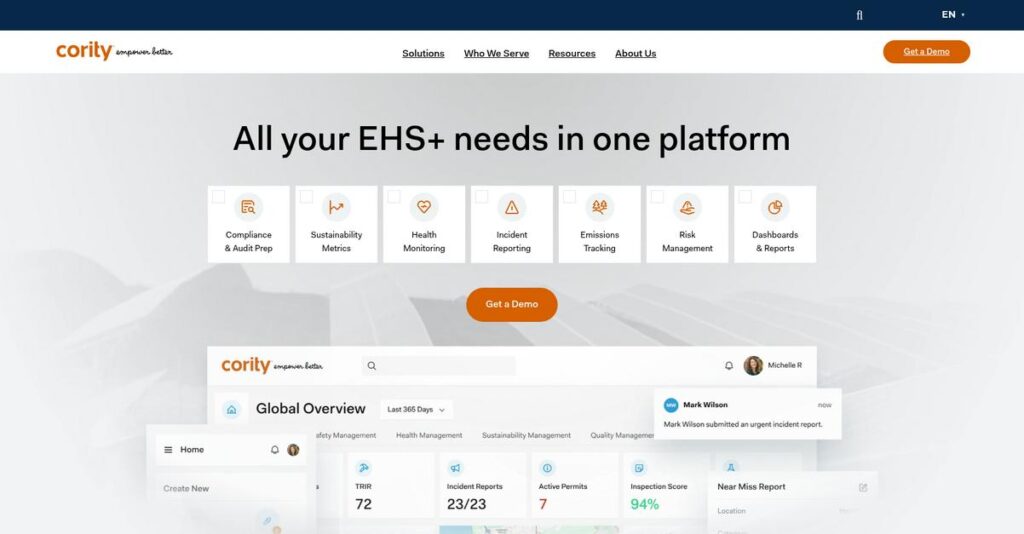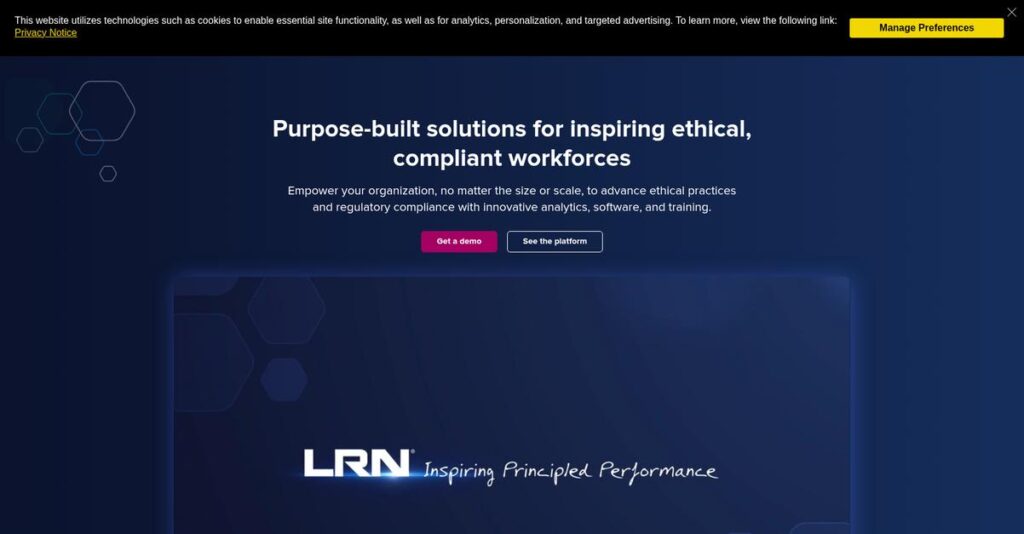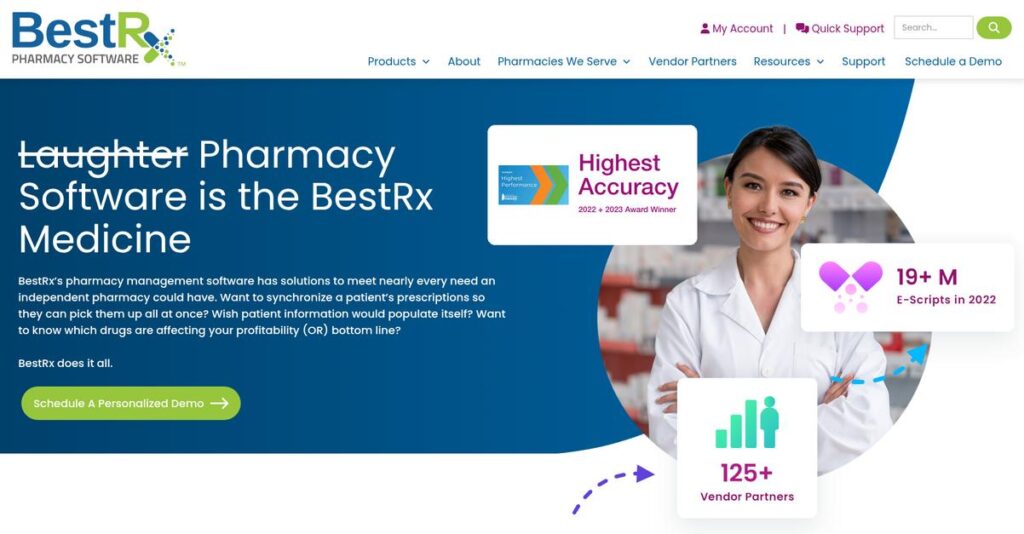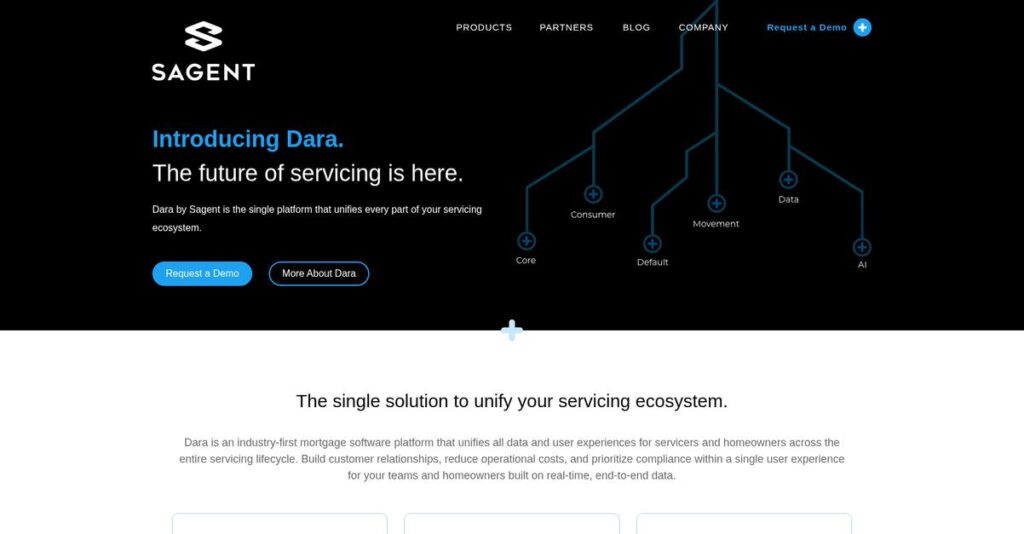Managing EHSQ data shouldn’t be this frustrating.
If you’re dealing with too many spreadsheets, endless audits, or disconnected systems, it’s natural to start searching for something better—like Cority.
The biggest problem I see? All this manual work leaves you overwhelmed and uncertain, never sure if compliance or safety tasks are falling through the cracks.
Cority takes a unified platform approach to help you consolidate safety, environmental, health, quality, and ESG data in one place, with advanced analytics and mobile tools that actually reduce your daily admin burden. Their recent innovation in occupational health and strong configurability set them apart if you need true flexibility.
In this review, I’ll break down how you can take control of EHSQ management without patchwork fixes or wasted time.
You’ll find in this Cority review: how features work in practice, real-world benefits, pricing, potential drawbacks, and alternatives, making your decision much simpler.
You’ll come away knowing the features you need to finally run EHSQ as efficiently as you want.
Let’s get started.
Quick Summary
- Cority is an integrated cloud platform that helps your team manage environmental, health, safety, quality, and sustainability programs.
- Best for medium to large enterprises needing to streamline complex EHSQ and ESG compliance and reporting.
- You’ll appreciate its strong configurability and expert support that help your company tailor processes without extra licenses.
- Cority offers quote-based pricing with no free trial but provides demos to evaluate fit before purchase.
Cority Overview
Based in Toronto, Cority has been in the EHSQ game since 1985. Their core mission is empowering organizations like yours to proactively manage comprehensive health, safety, and sustainability responsibilities across the enterprise.
They primarily serve large, complex organizations in high-risk sectors that need a unified platform. What I find interesting is their people-first approach to software solutions, aiming to make intricate EHSQ management feel more intuitive for your actual teams on the ground.
Recent developments, like the 2025 Meddbase acquisition, seriously strengthen their Health Cloud capabilities. Through this Cority review, you’ll see this demonstrates a clear and consistent commitment to platform innovation.
Unlike competitors with disjointed offerings, Cority emphasizes a truly unified EHSQ and ESG platform. This holistic approach feels built by practitioners who understand the operational big picture, not just checking compliance boxes.
They work with over 1,500 global organizations, including major names in manufacturing and chemicals. These businesses typically require a highly configurable system to manage their complex and challenging operational risks.
I found their strategy centers on the CorityOne platform, creating a single source of truth for all your data. This addresses the immense pressure for trustworthy ESG reporting and gaining intelligence from combined EHSQ programs.
Now let’s examine their capabilities.
Cority Features
Dealing with disconnected EHSQ and ESG tools?
Cority solutions can help you unify your EHSQ and ESG programs on a single platform. Here are the five core Cority solutions that bring your operational data together.
1. Safety Cloud
Frustrated with inconsistent incident reporting?
Manual or siloed safety processes make it hard to track incidents and learn from near-misses. This can put your team at risk.
Cority’s Safety Cloud centralizes incident reporting and investigation, simplifying compliance and task automation. From my testing, the mobile interface for field reporting truly shines, ensuring timely data capture even offline. This solution helps standardize processes to reduce recurrence and fosters a proactive safety culture.
This means you get clearer insights into safety risks, helping you meet compliance like RIDDOR reporting with less effort.
- 🎯 Bonus Resource: While we’re discussing operational efficiency, my article on best cloud phone system covers communication solutions.
2. Environmental Cloud
Struggling to meet evolving climate goals?
Managing environmental data across disparate systems can lead to compliance headaches and inaccurate reporting. You need a unified view.
The Environmental Cloud helps you track emissions, manage waste, and monitor air and water quality from one place. What I love about this approach is how it integrates with systems like SCADA for accurate agency reporting. This solution transforms complex regulatory requirements into manageable workflows.
The result is you can confidently manage your environmental footprint and ensure you meet demanding sustainability targets.
3. Health Cloud
Worried about total workforce well-being?
Handling occupational health, medical records, and industrial hygiene manually can be complex and error-prone. This impacts employee health and compliance.
Cority’s Health Cloud provides comprehensive tools for occupational health, medical record keeping, and industrial hygiene. Here’s the thing – it centralizes employee health data to ensure total worker well-being. This feature, strengthened by recent acquisitions like Meddbase, supports everything from routine check-ups to complex medical practice management.
So as an EHS professional, you get a robust system to protect your workforce and boost their overall performance.
4. Quality Cloud
Still relying on paper for quality control?
Traditional, paper-driven quality processes can slow down improvements and make compliance audits a nightmare. This limits efficiency.
The Quality Cloud moves you beyond paper, streamlining document control, CAPA, and supplier quality management. What you get instead is a unified system for continuous improvement, making compliance with standards like CFR Part 11 straightforward. This solution helps you track non-conformances and manage employee training effectively.
This means you can drive continuous improvements, ensuring your operations meet industry standards and customer mandates without sacrificing speed.
5. Sustainability Cloud
Need to report ESG goals with confidence?
Gathering, managing, and reporting sustainability data can be overwhelming, especially with growing stakeholder and regulatory demands.
Cority’s Sustainability Cloud simplifies how you track and report ESG data, ensuring compliance with global standards. From my testing, this solution helps develop net-zero strategies and manage carbon disclosures efficiently. This helps position your organization as a leader in mitigating climate impacts and satisfying key stakeholders.
So you can confidently demonstrate your commitment to sustainability and meet increasingly rigorous reporting requirements.
Pros & Cons
- ✅ Integrated CorityOne platform provides a unified approach to EHSQ and ESG.
- ✅ Highly configurable system allows flexible adaptation to specific business processes.
- ✅ Expert EHS domain knowledge from Cority consultants supports effective implementation.
- ⚠️ Some users report the user interface (UI) feels outdated or clunky.
- ⚠️ Customer support responsiveness can be inconsistent for certain issues.
- ⚠️ Specific advanced reporting features may require greater customization flexibility.
You’ll actually appreciate how these Cority features work together as an integrated EHSQ and ESG ecosystem rather than separate tools, consolidating your data and workflows efficiently.
Cority Pricing
Worried about complex software costs?
Cority pricing operates on a custom quote model, meaning you’ll need to contact sales, but this also ensures a cost structure tailored to your specific EHSQ and ESG requirements.
Cost Breakdown
- Base Platform: Custom quote (indicative enterprise starting point: USD 50,000/year)
- User Licenses: Varies by number of users
- Implementation: Varies by complexity; “packaged implementation” available for Safety Essentials
- Integrations: Varies by complexity and additional requirements
- Key Factors: Modules required, number of users, implementation complexity
1. Pricing Model & Cost Factors
Understanding Cority’s unique approach.
Cority’s pricing model is entirely quote-based, meaning there are no public tiers or fixed plans. What I found regarding pricing is that your total cost depends significantly on selected modules, the number of users, and the intricacy of your implementation. Factors like specialized EHSQ or ESG solutions and data migration complexity directly influence the final quote.
From my cost analysis, this means your monthly costs will be precisely aligned with your organization’s specific requirements.
2. Value Assessment & ROI
How does Cority deliver value?
While Cority’s pricing is custom, its comprehensive CorityOne platform aims to reduce the need for multiple disparate systems. From my cost analysis, this integrated approach often leads to significant ROI by streamlining workflows and enhancing compliance, avoiding the hidden costs associated with managing separate solutions. It helps you save through efficiency.
This ensures your budget supports a unified, proactive approach to EHSQ, yielding long-term operational savings.
- 🎯 Bonus Resource: While we’re discussing unified approaches, understanding customer communications management software is equally important for holistic business operations.
3. Budget Planning & Implementation
Planning for total cost of ownership.
Beyond the initial quote, consider implementation costs, especially for complex integrations or bespoke workflows beyond standard packages. What stood out about their pricing is that initial “packaged implementation” can accelerate deployment, but additional scope will incur extra effort and cost in follow-on phases.
So for your business, expect to allocate budget not just for the subscription but also for thorough setup and integration.
My Take: Cority’s custom pricing model makes it ideal for large enterprises seeking a highly tailored, integrated EHSQ and ESG solution, ensuring you only pay for what you truly need.
The overall Cority pricing reflects custom enterprise-level value for comprehensive EHSQ solutions.
Cority Reviews
What do customers truly think?
Analyzing Cority reviews provides a clear picture of user experiences, drawing insights from platforms like G2 and FeaturedCustomers to understand real-world sentiment.
1. Overall User Satisfaction
Users seem generally satisfied.
- 🎯 Bonus Resource: While discussing overall satisfaction, ensuring precise project delivery through excellent requirements management software is also key.
From my review analysis, Cority consistently earns strong ratings, averaging 4.0 out of 5 on G2 and 4.7 on FeaturedCustomers. What I found in user feedback is that flexibility in configuration often drives satisfaction, allowing the system to truly adapt to diverse business processes.
This suggests you can expect a highly customizable platform that integrates well into your existing workflows.
2. Common Praise Points
Flexibility wins consistent praise.
Users frequently praise Cority’s flexible configuration, especially its ability to customize workflows and forms without extra licenses. From the reviews I analyzed, the system’s ability to integrate diverse data and provide actionable insights is a significant advantage, as is the expert coaching during implementation.
This means you’ll benefit from a system that adapts to your needs and expert guidance throughout setup.
3. Frequent Complaints
User interface is a recurring concern.
While highly functional, some users consistently point to the user interface as a major drawback. What stands out in customer feedback is how UI concerns can impact daily usability, with some finding it less intuitive or visually appealing than desired, and others noting slow support responses.
These issues are worth noting, but they don’t seem to overshadow the core functionality for most users.
What Customers Say
- Positive: “Flexibly, the system doesn’t needs any additional permissions or licenses to make any changes to the Application workflows, Forms etc.” (User on G2)
- Constructive: “UI, UI is the major drawback i felt. The UI is not really looking good.” (User on G2)
- Bottom Line: “Our partnership with Cority has enabled us to improve data accuracy and has increased our confidence.” (Royal Mail)
The overall Cority reviews indicate a highly functional, flexible platform, though UI and support responsiveness can be mixed.
Best Cority Alternatives
Considering other EHSQ and ESG software options?
The best Cority alternatives include several strong options, each better suited for different business situations, budget considerations, and specific EHSQ/ESG priorities.
1. Gensuite
Prioritizing a long-standing, robust EHS system?
Gensuite (Benchmark Gensuite) is a comprehensive alternative, often chosen by organizations prioritizing a well-established EHS platform. From my competitive analysis, Gensuite provides robust, long-standing EHS system capabilities for diverse needs, though it may lack Cority’s specialized occupational health focus and integrated approach.
Choose Gensuite if you need a dependable, broad EHS system without Cority’s specific people-first health integration.
- 🎯 Bonus Resource: Speaking of making informed software choices, you might find my guide on Court Management Software helpful for specific legal situations.
2. EHS Insight
Seeking a more out-of-the-box, user-friendly solution?
EHS Insight offers a strong EHS solution with a notable focus on ease of use and streamlined reporting, ideal for simpler deployments. What I found comparing options is that EHS Insight focuses on intuitive use and quick deployment for core EHS, whereas Cority suits more intricate, custom enterprise needs.
Consider this alternative when you prioritize user-friendliness and faster implementation over extensive enterprise-level configurability.
3. Enablon
Emphasizing operational risk management within large enterprises?
Enablon provides extensive EHS and operational risk management software, often competing for large enterprise clients with complex needs. Alternative-wise, Enablon offers deep operational risk management capabilities for established corporate environments, though Cority highlights a more unified SaaS platform and expert support.
Choose Enablon if your primary focus is comprehensive operational risk management alongside EHS solutions for your large organization.
4. VelocityEHS
Mainly focused on robust safety management and compliance?
VelocityEHS is a prominent EHS management software vendor, known for its strong emphasis on workplace safety and compliance. From my analysis, VelocityEHS excels in focused safety management functionalities, while Cority offers a broader, deeply integrated EHSQ and ESG suite across all pillars.
Consider this alternative when your core requirement is robust, dedicated safety management rather than a full EHSQ/ESG integrated platform.
Quick Decision Guide
- Choose Cority: Complex EHSQ/ESG needs, deep health integration, unified platform
- Choose Gensuite: Robust, long-standing EHS system with broad capabilities
- Choose EHS Insight: Ease of use and quick deployment for core EHS needs
- Choose Enablon: Large enterprise operational risk and EHS management
- Choose VelocityEHS: Primary focus on robust safety management and compliance
The best Cority alternatives depend on your specific business size, budget, and EHSQ priorities rather than features alone.
Cority Setup
Wondering about Cority implementation complexities?
Successfully deploying Cority requires careful planning and a realistic understanding of the processes involved. This Cority review section explores what to expect from setup and adoption.
1. Setup Complexity & Timeline
Expect a detailed, consultative deployment process.
Cority’s highly configurable nature means implementation involves tailoring the solution to your specific workflows and business rules. From my implementation analysis, additional scope beyond core features increases effort, requiring careful planning for realistic timeframes and resources to ensure success.
You’ll need a clear project scope and internal champions to manage configuration, ensuring alignment with your operational needs.
2. Technical Requirements & Integration
Infrastructure and integration challenges often arise.
Cority is cloud-based and browser-accessible, simplifying some technical requirements, but complex integrations with existing systems are common. What I found about deployment is that data migration and external system integration can be the most time-consuming technical aspects.
Plan for IT readiness and allocate resources for data mapping and connecting Cority to your current operational software.
- 🎯 Bonus Resource: While we’re discussing operational software, understanding hotel channel management software is equally important for various business needs.
3. Training & Change Management
User adoption is crucial for long-term success.
Cority offers various training resources, and the mobile capabilities help field workers, but user training on new workflows remains key. From my analysis, expert coaching from Cority’s EHS professionals significantly aids in successful user adaptation and efficient system use.
Invest in formal training programs and establish internal experts to guide your team through new processes and maximize adoption.
4. Support & Success Factors
Vendor support significantly impacts implementation.
Cority provides expert-guided deployment and consulting, with users praising the value of EHS domain specialists during configuration. From my implementation analysis, having EHS experts assisting during setup is a critical differentiator and a major success factor for your team.
Prioritize leveraging Cority’s consulting services and maintain strong communication with their support team for a smooth implementation.
Implementation Checklist
- Timeline: Variable, depending on configuration complexity
- Team Size: Dedicated project manager, EHS team, IT staff
- Budget: Professional services for expert-guided configuration
- Technical: Data migration and integration with existing systems
- Success Factor: Leveraging Cority’s EHS expert consulting services
Overall, successful Cority setup requires strategic planning and leveraging expert support to fully customize and integrate the platform into your operations.
Bottom Line
Is Cority the right choice for your business?
My Cority review shows a powerful, comprehensive platform for large enterprises navigating complex EHSQ and ESG challenges, requiring careful consideration of your specific needs.
1. Who This Works Best For
Large enterprises with complex EHSQ and ESG needs.
- 🎯 Bonus Resource: While discussing overall operational efficiency, my guide on Best Farm Management Software can help boost your farm’s productivity and profits.
Cority is ideal for global organizations and medium-to-large enterprises, particularly in regulated industries like manufacturing, healthcare, and energy. What I found about target users is that businesses needing a single, scalable platform to integrate diverse EHSQ functions will find it immensely valuable.
You’ll succeed if you’re transitioning from disparate systems and prioritize robust compliance, safety, and sustainability reporting.
2. Overall Strengths
Unmatched comprehensive integration and configurability.
The software excels through its unified CorityOne platform, providing deep integration of EHSQ and ESG functions with high configurability. From my comprehensive analysis, its expert domain knowledge supports complex regulatory needs, empowering data-driven decisions and adaptability to evolving compliance requirements.
These strengths allow your organization to streamline processes, improve data accuracy, and achieve significant operational excellence.
3. Key Limitations
Pricing transparency and UI concerns are notable.
While powerful, Cority’s quote-based pricing lacks transparency, and some users note the user interface could be more modern. Based on this review, you won’t find a free trial or freemium version, making upfront evaluation more challenging for those on tight budgets or seeking quick assessments.
These limitations aren’t deal-breakers for enterprises, but they require careful consideration of your budget and team’s UI preferences.
4. Final Recommendation
Cority earns a strong recommendation for suitable enterprises.
You should choose Cority if your organization requires an integrated, highly configurable solution for complex EHSQ and ESG management. From my analysis, your success depends on matching your business’s scale to its robust capabilities and investing in proper implementation support from Cority’s experts.
My confidence level is high for large enterprises but less so for small businesses with simpler, less integrated EHSQ needs.
Bottom Line
- Verdict: Recommended for large enterprises with complex EHSQ/ESG needs
- Best For: Global organizations and large companies in regulated industries
- Business Size: Medium to large enterprises, particularly those with complex compliance
- Biggest Strength: Integrated CorityOne platform with high configurability
- Main Concern: Quote-based pricing lacks transparency; UI could be improved
- Next Step: Contact Cority for a demo and detailed quote based on your needs
This Cority review highlights strong value for the right enterprise profile while acknowledging key considerations for your decision process.






